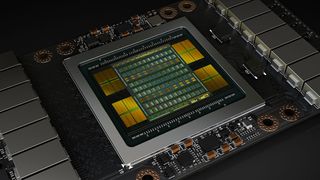Nvidia CEO says Moore’s Law is dead and GPUs will replace CPUs
Breaking the law.

In case you were unaware, Moore's Law is no longer relevant, as GPUs are advancing at a much faster pace than CPUs. That was the message from Nvidia CEO Jensen Huang, who stated at the GPU Technology Conference (GTC) 2017 in Beijing, China that graphics processors are on track to replace CPUs, SegmentNext reports.
Moore's Law is the name given to an observation made by Intel co-founder Gordon Moore in 1965. Moore noticed that the number of transistors per square inch on integrated circuits had doubled every year, and he predicted that would be the case for the next decade. He later revised his prediction to every two years.
Usually when people talk about Moore's Law coming to an end, they're referring to technical roadblocks that stand in the way of cramming more transistors into smaller spaces, while maintaining the same leaps in performance. Huang partially agrees with that, at least as it pertains to CPU performance—he said that while CPU transistors have grown at a pace of 50 percent annually, performance only jumps by 10 percent.
The other reason Huang says Moore's Law is dead is because it can't keep pace with advancements in GPU design. Huang talked about GPUs growing in computational capacity over the years, and how they're the better suited for advancements in artificial intelligence.
Huang also said that GPUs will replace CPUs soon, adding that at this point, designers can hardly work out advanced parallel instruction architectures for CPUs.
Intel would obviously disagree with Nvidia's assessment, and has on occasion. Around a year ago, Intel CEO Brian Krzanich downplayed reports of Moore's Law coming to an end.
"In my 34 years in the semiconductor industry, I have witnessed the advertised death of Moore’s Law no less than four times. As we progress from 14 nanometer technology to 10 nanometer and plan for 7 nanometer and 5 nanometer and even beyond, our plans are proof that Moore’s Law is alive and well," Krzanich stated in a blog post outlining Intel's plans. "Intel’s industry leadership of Moore’s Law remains intact, and you will see continued investment in capacity and R&D to ensure so."
PC Gamer Newsletter
Sign up to get the best content of the week, and great gaming deals, as picked by the editors.
More recently, Intel brought up Moore's Law when showcasing for the first time a 10nm Cannon Lake wafer at its Technology and Manufacturing Day in Beijing.
"Intel manufacturing processes advance according to Moore’s Law, delivering ever more functionality and performance, improved energy efficiency and lower cost-per-transistor with each generation," said Stacy Smith, group president of Manufacturing, Operations and Sales. "We are pleased to share in China for the first time important milestones in our process technology roadmap that demonstrate the continued benefits of driving down the Moore’s Law curve."
This all amounts to chest thumping on both sides, though there is more at stake than bragging rights. While Huang isn't necessarily asserting that GPUs will power consumer desktops while kicking CPUs to the curb, he does anticipate GPUs playing a larger role in supercomputers and specialized categories, such as AI, machine learning, cloud computing, and so forth.
Paul has been playing PC games and raking his knuckles on computer hardware since the Commodore 64. He does not have any tattoos, but thinks it would be cool to get one that reads LOAD"*",8,1. In his off time, he rides motorcycles and wrestles alligators (only one of those is true).
Most Popular






